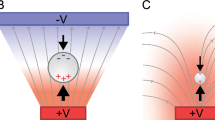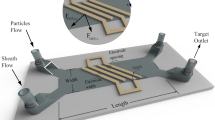Abstract
This paper reports a new portable microfluidic platform, “lab-on-a-display,” that microparticles are manipulated by optoelectronic tweezers (OET) on a liquid crystal display (LCD). The OET has been constructed by assembling a ground layer, a liquid chamber, and a photoconductive layer. Without lens or optical alignments, the LCD image directly forms virtual electrodes on the photoconductive layer for dielectrophoretic manipulation. The lab-on-a-display was first realized by a conventional monochromatic LCD module and a light source brighter than 5,000 lux. It was successfully applied to the programmable manipulation of 45 μm polystyrene beads; more than 100 particles were transported with an optical image-driven control, following the moving edge of the image at every moment. The effects of bead size and bias voltage on the manipulation speed were also investigated. Due to the portability and compatibility for disposable applications, this new platform has potential for programmable particle manipulation or chip-based bioprocessing including cell separation and bead-based analysis.







Similar content being viewed by others
References
Abe M, Orita M, Yamazaki H, Tsukamoto S, Teshima Y, Sakai T, Ohkubo T, Momozawa N, Sakai H (2004) Three-dimensional arrangements of polystyrene latex particles with a hyperbolic quadruple electrode system. Langmuir 20:5046–5051
Chiou PY, Ohta AT, Wu MC (2005) Massively parallel manipulation of single cells and microparticles using optical images. Nature 436:370–372
Choi S, Park J-K (2005) Microfluidic system for dielectrophoretic separation based on a trapezoidal electrode array. Lab Chip 5:1161–1167
Dittrich PS, Manz A (2006) Lab-on-a-Chip: microfluidics in drug discovery. Nat Rev Drug Discov 5:210–218
Doh I, Cho Y-H (2005) A continuous cell separation chip using hydrodynamic dielectrophoresis (DEP) process. Sens Actuators A, Phys 121:59–65
Hughes MP (2002) Strategies for dielectrophoretic separation in laboratory-on-a-chip systems. Electrophoresis 23:2569–2582
Krupke R, Hennrich F, Löhneysen Hv, Kappes MM (2003) Separation of metallic from semiconducting single-walled carbon nanotubes. Science 301:344–347
Lagally ET, Lee S-H, Soh HT (2005) Integrated microsystem for dielectrophoretic cell concentration and genetic detection. Lab Chip 5:1053–1058
Lao AIK, Hsing I-M (2005) Flow-based and sieving matrix-free DNA differentiation by a miniaturized field flow fractionation device. Lab Chip 5:687–690
Li H, Bashir R (2002) Dielectrophoretic separation and manipulation of live and heat-treated cells of Listeria on microfabricated devices with intedigitated electrodes. Sens Actuators B, Chem 86:215–221
Lu Y-S, Huang Y-P, Yeh AJ, Lee C, Chang Y-H (2005) Controllability of non-contact cell manipulation by image dielectrophoresis (iDEP). Opt Quantum Electron 37:1385–1395
Manaresi N, Romani A, Medoro G, Altomare L, Leonardi A, Tartagni M, Guerrieri R (2003) A CMOS chip for individual cell manipulation and detection. IEEE J Solid-St Circ 38:2297–2305
Minerick AR, Zhou R, Takhistov P, Chang H-C (2003) Manipulation and characterization of red blood cells with alternating current fields in microdevices. Electrophoresis 24:703–3717
Perch-Nielsen IR, Bang DD, Poulsen CR, El-Ali J, Wolff A (2003) Removal of PCR inhibitors using dielectrophoresis as a selective filter in a microsystem. Lab Chip 3:212–216
Ryu JI, Won SH, Hur JH, Kim HJ, Jang J, Jang GJ, Lee CW, Jung ST, Moon BY (2001) A novel amorphous silicon photoconductor array. J Korean Phys Soc 39:S264-S267
Verpoorte E (2003) Beads and chips: new recipes for analysis. Lab Chip 3:60N–68N
Wang X-B, Yang J, Huang Y, Vykoukal J, Becker FF, Gascoyne PRC (2000) Cell separation by dielectrophoretic field-flow-fractionation. Anal Chem 72:832–839
Washizu M, Suzuki S, Kurosawa O, Nishizaka T, Shinohara T (1994) Molecular dielectrophoresis of biopolymers. IEEE T Ind Appl 30:835–843
Acknowledgments
This research was supported by the Nano/Bio Science & Technology Program (M10536090002-05N3609-00210) of the Ministry of Science and Technology (MOST), Korea. The authors also thank CHUNG Moon Soul Center for BioInformation and BioElectronics, KAIST. The microfabrication works were performed at the Digital Nanolocomotion Center (KAIST, Daejeon, Korea) and the TFT-LCD Research Center (Kyung Hee University, Seoul, Korea).
Author information
Authors and Affiliations
Corresponding author
Rights and permissions
About this article
Cite this article
Choi, W., Kim, SH., Jang, J. et al. Lab-on-a-display: a new microparticle manipulation platform using a liquid crystal display (LCD). Microfluid Nanofluid 3, 217–225 (2007). https://doi.org/10.1007/s10404-006-0124-5
Received:
Accepted:
Published:
Issue Date:
DOI: https://doi.org/10.1007/s10404-006-0124-5




